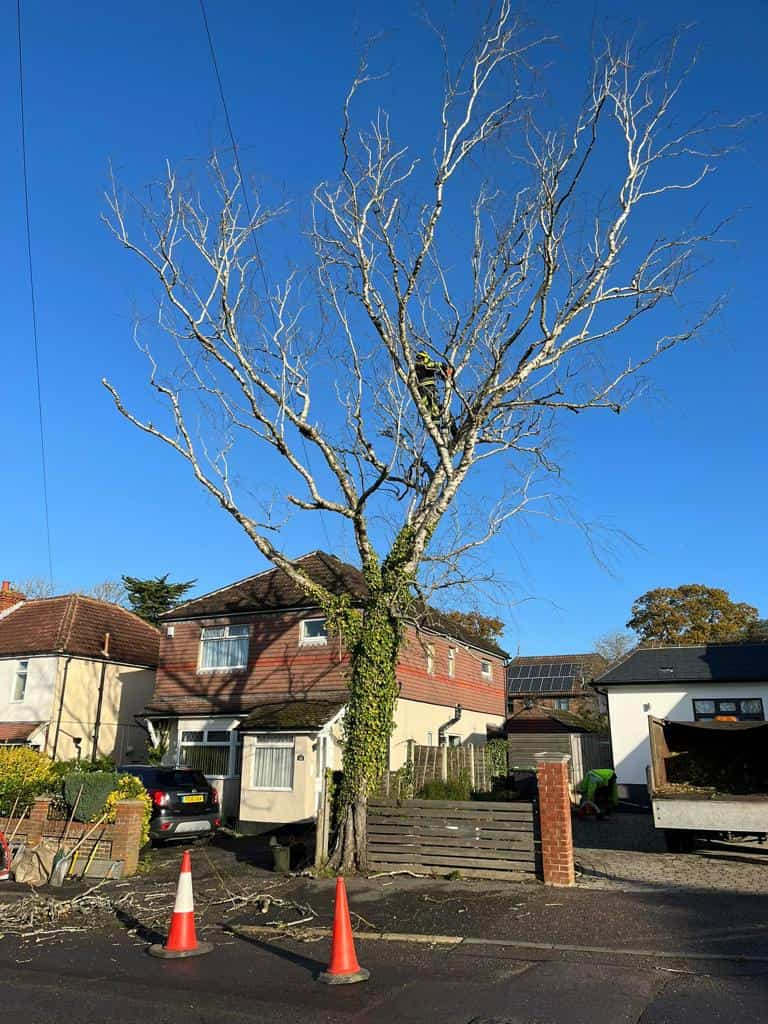Introduction
In Haslemere and many surrounding areas of Surrey, homes are often graced with mature trees that have grown over the decades—sometimes long before extensions, patios, or landscaping were added. While these trees can be a beautiful asset, their size can become problematic in smaller gardens, causing issues such as shading, crowding, and even structural stress.
At LM Tree Surgery Haslemere, we’re often called in to find solutions that strike a balance: how to retain these wonderful large trees while making the space around them more practical and inviting. One of the most effective answers? Professional crown work.
Why Tree Size Matters in Compact Spaces
When a large tree dominates a small garden, it can overwhelm the space. The canopy may block light from your home or garden beds, drop heavy debris, or interfere with property boundaries. Over time, this imbalance can affect both the health of the tree and the usability of your garden.
Key challenges include:
- Reduced natural light in gardens and inside your home
- Overhanging limbs creating safety or property issues
- Shading of other plants, preventing growth beneath the tree
- Blocked views or cluttered aesthetics, particularly in well-maintained gardens
But before jumping to the idea of removing the tree, crown work offers a much more elegant—and environmentally conscious—solution.
What Is Crown Work?
Crown work is a category of tree surgery that involves selective pruning and shaping of a tree’s upper structure—its branches, limbs, and canopy. The aim is to improve balance, safety, light penetration, and long-term health, without compromising the integrity of the tree.
There are several types of crown work that can be tailored to suit both the tree and the space around it:
- Crown reduction – Decreases the height and/or spread of the tree’s canopy
- Crown thinning – Removes select internal branches to allow more light and airflow
- Crown lifting – Raises the lower branches to improve ground-level access or light
- Crown cleaning – Removes dead, diseased, or damaged limbs for safety and health
Each technique addresses specific problems while preserving the essential character of the tree.
Making a Large Tree Garden-Friendly
In a small garden, a well-executed crown reduction is often the key to managing space without removing the tree altogether. By selectively shortening outer branches, arborists can subtly reduce the canopy size while retaining the tree’s natural form.
Benefits of crown work in compact gardens:
- Increased sunlight, especially for patios, lawns, or windows
- More usable garden space, especially around furniture or walkways
- Reduced leaf litter and debris, making upkeep easier
- Improved safety, particularly from deadwood or overextended limbs
- Preserved privacy, without total shade
At LM Tree Surgery Haslemere, we often find that one session of strategic pruning can completely transform a small outdoor space.
Why Crown Work Should Be Done Professionally
Working on a large tree—especially in a tight space—is not a job for a weekend gardener. Poorly executed pruning can weaken the tree, cause stress, or leave it vulnerable to disease. Worse, incorrect cutting can make the tree grow back in odd, unbalanced ways that are harder to manage later.
Professional crown work ensures:
- Safe removal of branches, using correct tools and techniques
- Accurate assessment of which limbs to remove or retain
- Minimal disruption to the surrounding area, especially in compact gardens
- Compliance with tree protection laws, if the tree is under a preservation order
Our trained arborists at LM Tree Surgery Haslemere understand how to shape trees in a way that is both sustainable and visually appealing.
When to Schedule Crown Work
Crown work is most effective during the tree’s dormant season—typically from late autumn to early spring—when leaves are gone and the tree can better cope with pruning stress. However, if safety is a concern, such as from storm damage or hanging limbs, intervention can and should happen at any time of year.
Look out for signs such as:
- Overhanging branches touching buildings or blocking light
- Large limbs growing too close to property boundaries
- Dense canopy with little air or light passing through
- Fallen deadwood or broken limbs after wind
- Limited visibility or access around your garden
If you notice any of these, it’s time to consult a tree surgeon.
Conclusion
Having a large tree in a small garden doesn’t have to be a problem. In fact, it can be one of your garden’s greatest assets—if it’s managed correctly. Crown work offers an effective and elegant solution to balance space, light, safety, and aesthetics, without resorting to drastic measures.
LM Tree Surgery Haslemere provides expert crown work for residents across Haslemere and surrounding Surrey villages. Whether you’re looking to open up a shaded space, reduce risks, or simply reshape a tree to better suit your garden, our team can deliver thoughtful, tailored care that benefits both tree and homeowner. Don’t let an oversized canopy dominate your outdoor space—let us help you make it work.
Call us on: 01428 770 497
Click here to find out more about LM Tree Surgery Haslemere
Click here to complete our contact form and see how we can help with your tree’s needs.

